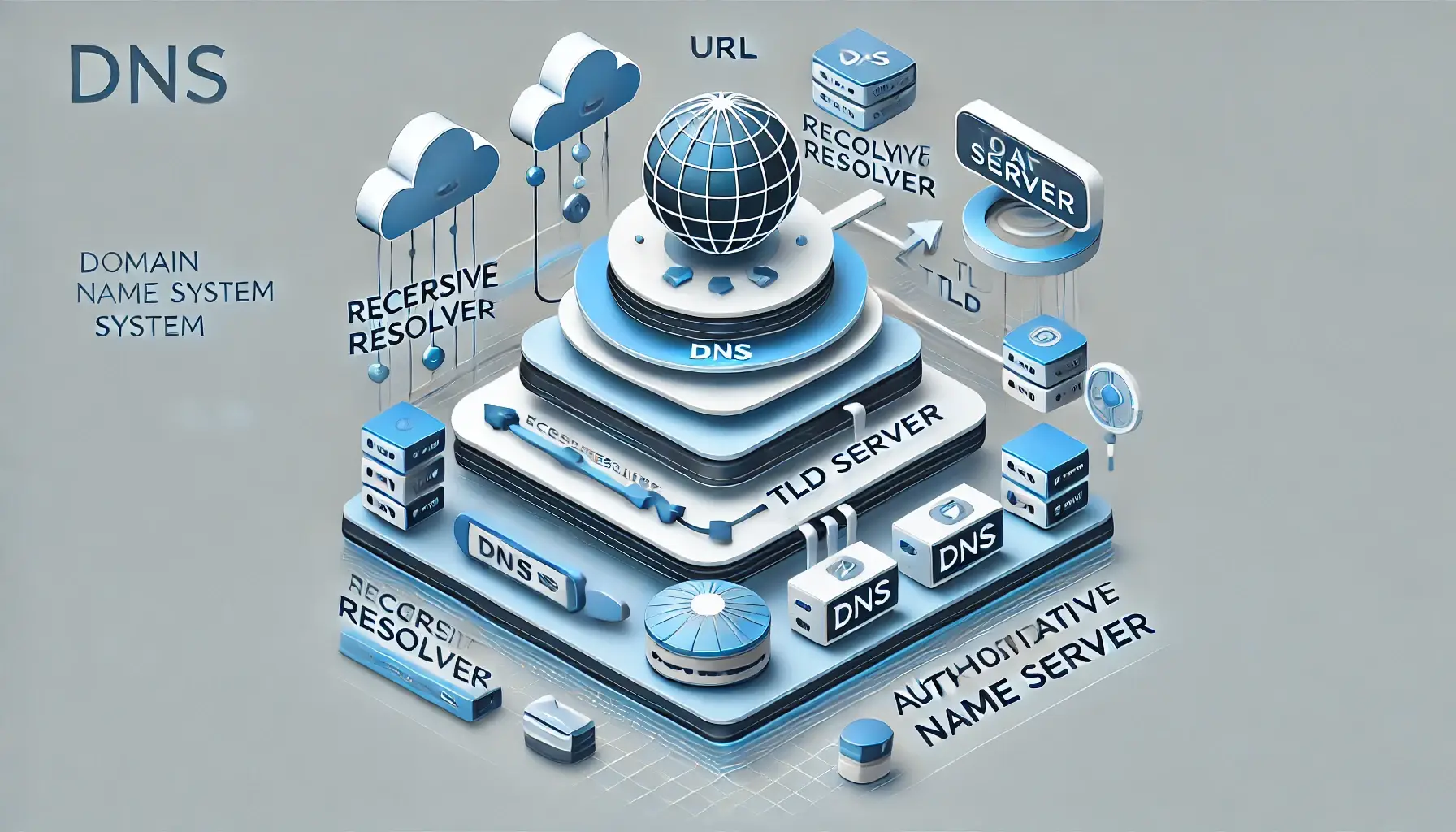Table of Contents
what is DNS and How It Works?
The Domain Name System (DNS) is a fundamental component of the internet, playing a pivotal role in how we access websites, connect to online services, and navigate the digital world. Without DNS, the internet would be much less user-friendly, requiring us to remember long strings of numbers (IP addresses) instead of the simple, memorable domain names we use every day.
In this blog post, we’ll dive deep into what is DNS, how it works, its key components, types, security considerations, and its essential role in internet functionality.
Introduction to DNS
The Domain Name System, or DNS, is often described as the “phonebook of the internet.” Essentially, DNS translates human-friendly domain names, like www.example.com, into IP addresses, like 192.0.2.1, that computers use to identify each other on the network. When you type a website’s name into your browser, DNS servers work behind the scenes to direct your request to the correct IP address, allowing you to access the site without needing to remember complicated numerical addresses.
This translation process is vital for making the internet as accessible and user-friendly as it is today. Without DNS, internet navigation would be complicated, inefficient, and far less intuitive.
The Purpose of DNS
At its core, DNS has a simple purpose: to map domain names to IP addresses. It serves as a crucial layer of abstraction, letting users communicate with servers using easily memorable names instead of IP addresses, which would be impractical to remember and type manually. Some of the key functions DNS performs include:
- Addressing – Matching domain names to IP addresses.
- Routing – Directing user requests to the correct server or service.
- Consistency – Ensuring the translation of domain names to IP addresses is uniform and consistent across the internet.
This consistent and reliable translation enables web browsers and other applications to connect seamlessly to websites, applications, and online services.
Understanding IP Addresses and Domain Names
Before diving further into DNS, it’s helpful to understand IP addresses and domain names, two foundational elements in DNS functioning.
IP Addresses
IP (Internet Protocol) addresses are numerical labels assigned to each device connected to a network, including websites, servers, and personal devices. These addresses ensure data is directed to the correct destination. For instance, IPv4 addresses (the older version) are structured as four numbers separated by periods, like 192.0.2.1, while IPv6 (the newer version) is structured in hexadecimal form, such as 2001:0db8:85a3:0000:0000:8a2e:0370:7334.
Domain Names
Domain names are human-friendly identifiers, like www.google.com, that are easier to remember and use. Each part of a domain name signifies different parts of the internet structure, with the top-level domain (like .com, .org, .net) serving as a categorization layer. Domain names eliminate the need to remember IP addresses, streamlining the internet user experience.
How DNS Works: The Key Components
The DNS system operates through a series of interconnected servers and databases, with specific components responsible for different parts of the translation and routing process. Here are the primary components involved in DNS:
1. DNS Resolver (Recursive Resolver)
A DNS resolver is a server that receives the user’s request and initiates the query process to find the IP address. This component’s role is to communicate with other DNS servers on behalf of the user, resolving the domain name into an IP address.
2. Root Name Servers
Root servers are the starting point of the DNS hierarchy, holding information on how to find Top-Level Domain (TLD) servers (like .com, .net, .org). There are only 13 root server systems globally, each managed by different organizations, which handle billions of DNS requests daily.
3. Top-Level Domain (TLD) Name Servers
The TLD name servers are responsible for handling requests for domains within specific top-level domains. For instance, .com TLD servers manage requests for websites ending in .com. When a request reaches the TLD server, it directs the query to the authoritative name server for the specific domain.
4. Authoritative Name Servers
The authoritative name server is where the actual IP address information for a domain is stored. It provides the final answer to the DNS query, delivering the IP address associated with the requested domain name to the DNS resolver.
5. DNS Cache
DNS caching is a crucial efficiency mechanism that stores previous query results to reduce response times for repeat requests. When a DNS resolver or a user’s browser caches a DNS record, it saves the IP address locally, allowing for quicker loading times on subsequent visits to the same domain.
The DNS Resolution Process Explained
Understanding how DNS works involves breaking down the DNS resolution process. Here’s a step-by-step look at what happens when you enter a URL into your browser:
- User Request Initiation
The process begins when a user types a domain name into their browser. The browser checks its DNS cache to see if the IP address is already saved from a previous visit. - DNS Resolver Query
If the IP address isn’t cached, the request goes to a DNS resolver, typically managed by the user’s ISP (Internet Service Provider). - Root Server Request
The DNS resolver queries a root server for information on where to find the TLD server associated with the requested domain (.com, .org, etc.). - TLD Server Query
The root server directs the resolver to the correct TLD server, which has information about where to find the authoritative name server for the domain. - Authoritative Name Server Query
The DNS resolver then queries the authoritative name server, which provides the specific IP address for the domain. - Returning the IP Address
Once the DNS resolver receives the IP address, it sends it back to the user’s browser, which uses it to establish a connection to the website’s server, allowing the page to load.
This entire process typically takes only milliseconds, highlighting the incredible efficiency of the DNS system.
Types of DNS Records and Their Roles
DNS records are critical data files within the DNS system that provide information about a domain and its associated services. Here are some common DNS record types and their purposes:
- A Record (Address Record)
Maps a domain name to an IPv4 address. - AAAA Record
Similar to an A record, but maps a domain to an IPv6 address. - CNAME Record (Canonical Name Record)
Maps one domain to another domain, often used for subdomains. - MX Record (Mail Exchange Record)
Specifies the mail servers responsible for receiving emails for the domain. - TXT Record
Holds text information for various purposes, including verification and authentication (often used in email verification). - NS Record (Name Server Record)
Specifies the authoritative name servers for a domain.
These records ensure DNS has the correct information to respond accurately to user requests, enabling seamless communication and efficient data routing across the internet.
DNS Security Considerations
Given its critical role in internet functionality, DNS is often a target for cyberattacks. Here are some common DNS-related security concerns:
1. DNS Spoofing/Cache Poisoning
DNS spoofing, or cache poisoning, is when a hacker inserts false information into a DNS cache. When users try to access a website, they’re directed to a malicious site instead. DNS spoofing can lead to data breaches, phishing attacks, and other security risks.
2. DNS Tunneling
DNS tunneling uses DNS as a covert communication channel to transmit malicious data or exfiltrate data from a network. Since DNS is essential and often allowed through firewalls, DNS tunneling can bypass security controls.
3. DDoS Attacks on DNS Servers
Distributed Denial of Service (DDoS) attacks flood DNS servers with excessive requests, causing the server to become unresponsive. This can lead to website downtime and reduced accessibility.
4. DNSSEC (DNS Security Extensions)
DNSSEC is a suite of security protocols that adds cryptographic authentication to DNS, ensuring that responses are legitimate. Although DNSSEC isn’t universally adopted, it’s a robust solution to prevent DNS-based attacks.
The Importance of DNS in Today’s Digital Landscape
DNS plays an essential role in keeping the internet functioning smoothly. It allows for the creation of a user-friendly, scalable internet that connects millions of websites, devices, and applications. In addition to enhancing usability, DNS supports e-commerce, digital marketing, online communication, and numerous other aspects of modern business and daily life.
Businesses can also utilize DNS for:
- Brand Consistency
Through domain names, DNS allows businesses to establish a consistent brand identity online. - Scalability
DNS infrastructure scales to support global access, making it ideal for growing businesses. - Content Delivery Optimization
DNS providers often include services like load balancing and content distribution that reduce latency, enhancing user experience.
FAQs About DNS and How It Works
What is DNS, and why is it important?
DNS is the Domain Name System that translates human-readable domain names into IP addresses. It’s crucial because it makes the internet user-friendly by allowing people to use simple names instead of complex IP addresses to access websites.
How long does a DNS query take?
A DNS query usually takes milliseconds, though it can vary depending on factors like network conditions, caching, and DNS server response times.
What is DNS caching, and how does it benefit users?
DNS caching stores previously requested DNS information, reducing the time needed for subsequent requests. It benefits users by enabling faster access to frequently visited websites.
What’s the difference between a DNS resolver and an authoritative name server?
A DNS resolver initiates the DNS query process on behalf of the user, while an authoritative name server holds the definitive IP address information for a domain.
what is DNS attacks and its common types?
Common DNS attacks include DNS spoofing, DNS tunneling, and DDoS attacks on DNS servers. These attacks can compromise user data, redirect users to malicious sites, and disrupt website access.
How can DNS security be improved?
Implementing DNSSEC, using firewalls, enabling DNS logging, and educating users on security practices are ways to improve DNS security.
What is DNS Server?
A DNS server converts domain names (e.g., www.example.com) into IP addresses, enabling quick and easy website access. It’s essential for smooth internet browsing.
Conclusion
The Domain Name System (DNS) is the backbone of internet accessibility and functionality. By translating domain names into IP addresses, DNS enables users to navigate the internet seamlessly. Despite its behind-the-scenes nature, DNS affects every part of our digital lives, from personal browsing to global business operations.
DNS’s robust structure, coupled with security measures and efficient processes, ensures that it remains a reliable and scalable solution in today’s digital landscape. By understanding DNS and its operations, we gain insight into the essential systems that make the internet accessible and efficient.





